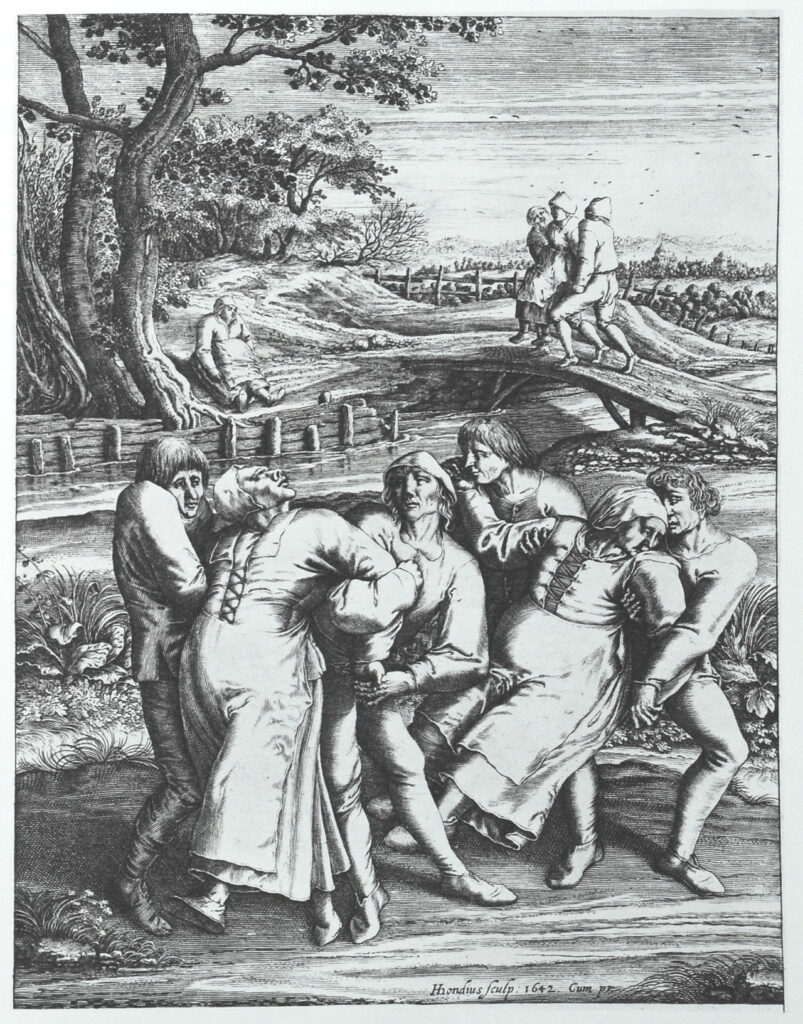Last updated on January 27th, 2023 at 08:08 pm
Everyone loves a chance to dance. Even mob dance parties that just pop up on the streets are seen as fun and entertaining.
But what if you were struck with a disease that left you dancing unwillingly for days? That is what happened in 1518.
Let’s dive into the dancing plague of 1518 and what happened during those two months.

The First Case Was in July 1518
In July 1518, Frau Troffea stepped into the streets of her town in Strasbourg, a free city within the Holy Roman Empire (now a part of France).
She began to dance, seeming unable to stop dancing no matter what others did around her. There was no music or noise, but she twisted, twirled, and shook her body.
Eventually, she collapsed due to exhaustion. But once she rested, the frenzied activity began again. It was nearly a week before she stopped, but that was the beginning of the dancing plague of 1518.
This phenomenon continued for days, but Mrs. Troffea was not the only one affected. Within a week, more than 30 people were also actively dancing to exhaustion before beginning the process all over again.
These people kept dancing and moving frantically, often to the point of injury. The increasing number of dancers alarmed city officials, who were not sure what was causing all of this frantic activity.
Local physicians blamed the dancing plague on hot blood, which meant that they thought the increasing activity would eventually end the plague altogether.
Civic and religious leaders thought more dancing would be the solution, causing them to reach exhaustion even faster. So these leaders arranged for guild halls to be opened up and allow the dancers to gather, with musicians playing and professional dancers helping those afflicted to keep dancing.
Instead of helping to end the dancing plague of 1518, it seemed only to worsen. As many as 400 people were eventually afflicted with the dancing plague. Many individuals ended up dying from the never-ending dancing because it triggered heart attacks and strokes.
By September, the dancers were sent away to a mountaintop shrine for prayers of absolution. While this plague might seem like the stuff of legends, it was actually well documented. But this was not the only mania that occurred.
Switzerland, Holland, and Germany also had similar plagues, although none were as large as the one triggered in 1518 at Strasbourg. The other best-known example of this type of dancing plague occurred in 1374, as it erupted through several towns up and down the Rhine River.
What Caused the Dancing Plague of 1518?
The cause of this mysterious dancing plague of 1518 was never discovered, although many theories abound based on historical and medical evidence.
It seems to stop as quickly as it started. Historians point to the religious belief that St. Vitus, a Catholic saint, could curse people with this dancing plague. Historian John Waller cited the series of famines, and the increased presence of smallpox and syphilis were the overwhelming stressors in 1518. Europeans also struggled to keep their families healthy and well-cared for, but the resources were limited.
It is also believed that the St. Vitus superstition could have triggered a stress-induced hysteria. Those who had epilepsy, and didn’t appease St. Vitus, were punished by being forced to dance.
American sociologist Robert Bartholomew argued that the dancers were not affected by a plague but were dancing to obtain divine favor. Others suggest that a cult might have been the cause of the dancing plague.
There is also a medical theory that ergot, a toxic mold found on damp rye, can produce spasms and hallucinations.
Essentially, it was as if a large swath of the population was poisoned by moldy rye. However, there is no definitive proof that these theories were the cause of the dancing plague of 1518.
The Discovery of Sydenham Chorea
Clearly, there was little scientific evidence to determine what caused this dancing plague outbreak of 1518. However, since then, medical science has advanced, and there may be a medical answer for this unique disease.
The St. Vitus dance, known as Sydenham chorea, is a neurological disorder. Sydenham chorea is caused by an infection by the bacteria A streptococcus.
An English physician, Thomas Sydenham, first explained the disorder, noting that it happened more frequently for girls than boys, typically occurring between the ages of 5 and 15.
It is often seen infrequently as a complication of pregnancy. In the past, people who suffered from it would go to the chapels of St. Vitus, praying for a cure.
The symptoms can range from mild to completely incapacitating. Jerking motions are involuntary, being most obvious in the extremities and face. Some individuals also suffer from involuntary movements in the trunk of their bodies. Speech and swallowing can also be impacted.
Those suffering from Sydenham chorea can also deal with irritability, emotional instability, and anxiety, often triggered by trivial incidents.
As the brain is studied more closely, potential causes of Sydenham chorea have come to the surface. One such potential cause is the malfunctioning basal ganglia and changes to the cerebral cortex.
Attacks of the disease can last several weeks, with frequent recurrence. Recovery is often accelerated by bed rest. When a patient suffers from a severe case, then tranquilizers can help to protect them from self-injurious behaviors.
Clearly, this dancing plague of 1518 had roots in physical and mental issues faced by the people of Strasbourg. While this disease has not disappeared, the tools to address the challenges that result are more available in the 21st century.
With increasing levels of stress due to various factors, it is clear that our minds will find a way to deal with it, even if that means dancing until you fall into a state of exhaustion.

